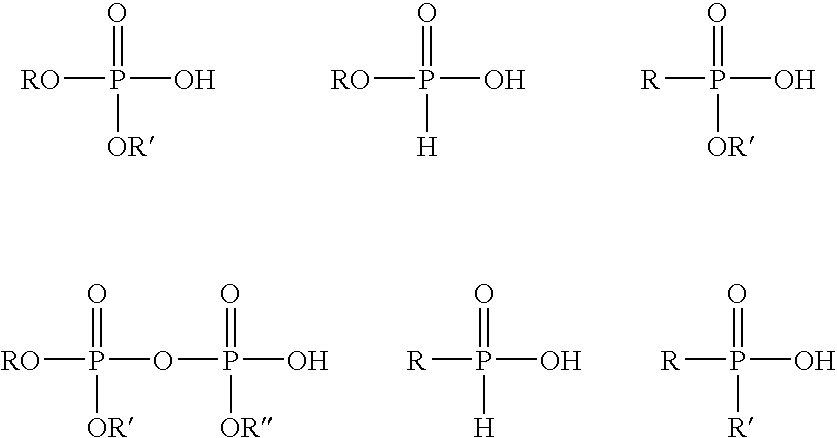Fast dry, shelf stable aqueous coating composition comprising a phosphorus acid polymer
a technology of phosphorus acid polymer and composition, which is applied in the direction of coatings, synthetic resin layered products, lighting and heating apparatus, etc., can solve the problems of insufficient drying speed, inability to dry aqueous road marking paint, and garzon compositions to exhibit a fast enough dry time for road markings, etc., to achieve wear resistance and viscosity stability
- Summary
- Abstract
- Description
- Claims
- Application Information
AI Technical Summary
Benefits of technology
Problems solved by technology
Method used
Image
Examples
synthesis examples
[0082]The following polymers in Examples 1, 2 and 3 and Comparatives A, B, C and D were synthesized, respectively from the monomer mixtures shown in the following Table 1A.
TABLE 1AEXAMPLE4 (for5 (forCompar-Compar-ativeative123A & B)C & D)IngredientgramsgramsgramsgramsgramsDI water22505755752115575EAES Surfactant1261.9261.958.2Surfactant 22—29.129.1Butyl acrylate283510401039.62835630Benzophenone12.512.9Methylmethacrylate5967916895.260481326Phosphoethyl102.622.836.722.8methacrylateMethacrylic acid451010.111710n-Dodecylmercaptan112.51010.0112.5251Ethoxylated C12 alkyl ether sulfate having an average of 4 EO groups per molecule (30% active-in water)2Ammonium salt of nonylphenolethoxylate sulfate (60% active in water)
synthesis — example 1
Polymer Synthesis—Example 1
[0083]To 3375 g of deionized (DI) water under a nitrogen atmosphere at 89° C. was added 36.9 g EAES surfactant, 14.4 g of ammonium bicarbonate dissolved in 135 g DI water, 22.5 g ammonium persulfate dissolved in 225 g DI water and 344.7 g monomer mixture 1 followed by 135 g of DI water to form a reaction mixture to which the remaining monomer mixture was then added at 86° C. over 80 minutes along with a solution of 13.5 g ammonium persulfate dissolved in 1700 g DI water.
[0084]At the end of the polymerization, 45 g ammonium hydroxide in 45 g DI water, 0.05 g FeSO4 in 31.5 g DI water mixed with 0.045 g ethylene diamine tetraacetic acid in 4.5 g DI water, 7.2 g t-butylhydroperoxide in 90 g DI water and 2.8 g isoascorbic acid in 180 g DI water were added at 65° C. to the reaction product. Ammonium hydroxide was added to give a final pH=9.8.
[0085]Ammonium hydroxide was added to give a final pH=9.8. To this was added 346.1 g of p(OXEMA), poly(oxazolidinylethyl m...
synthesis — example 2
Polymer Synthesis—Example 2
[0086]To 700 g of deionized (DI) water under a nitrogen atmosphere at 89° C. was added 4.1 g surfactant 2, 3.2 g of ammonium bicarbonate dissolved in 30 g DI water, 4.0 g ammonium persulfate dissolved in 26.5 g DI water and 80.2 g monomer mixture 2 followed by 25 g of DI water to form a reaction mixture. The remaining monomer mixture was then added at 86° C. over 80 minutes along with 0.03 g FeSO4 dissolved in 19.8 g DI water mixed with 0.03 g ethylenediamine tetraacetic acid dissolved in 3 g DI water, a solution of 4.0 g t-amyl hydroperoxide and 0.7 g surfactant 2 dissolved in 144.2 g DI water and a solution of 3.1 g Isoascorbic acid and 10.5 g ammonium hydroxide dissolved in 135 g DI water.
[0087]At the end of the polymerization, 0.29 g t-amylhydroperoxide and 0.15 g surfactant 2 in 29.3 g DI water and 0.9 g isoascorbic acid in 31 g DI water were added at 65° C. to the reaction product. Ammonium hydroxide was added to give a final pH=9.9. To this was adde...
PUM
| Property | Measurement | Unit |
|---|---|---|
| Tg | aaaaa | aaaaa |
| Tg | aaaaa | aaaaa |
| temperature | aaaaa | aaaaa |
Abstract
Description
Claims
Application Information
 Login to View More
Login to View More - R&D
- Intellectual Property
- Life Sciences
- Materials
- Tech Scout
- Unparalleled Data Quality
- Higher Quality Content
- 60% Fewer Hallucinations
Browse by: Latest US Patents, China's latest patents, Technical Efficacy Thesaurus, Application Domain, Technology Topic, Popular Technical Reports.
© 2025 PatSnap. All rights reserved.Legal|Privacy policy|Modern Slavery Act Transparency Statement|Sitemap|About US| Contact US: help@patsnap.com

